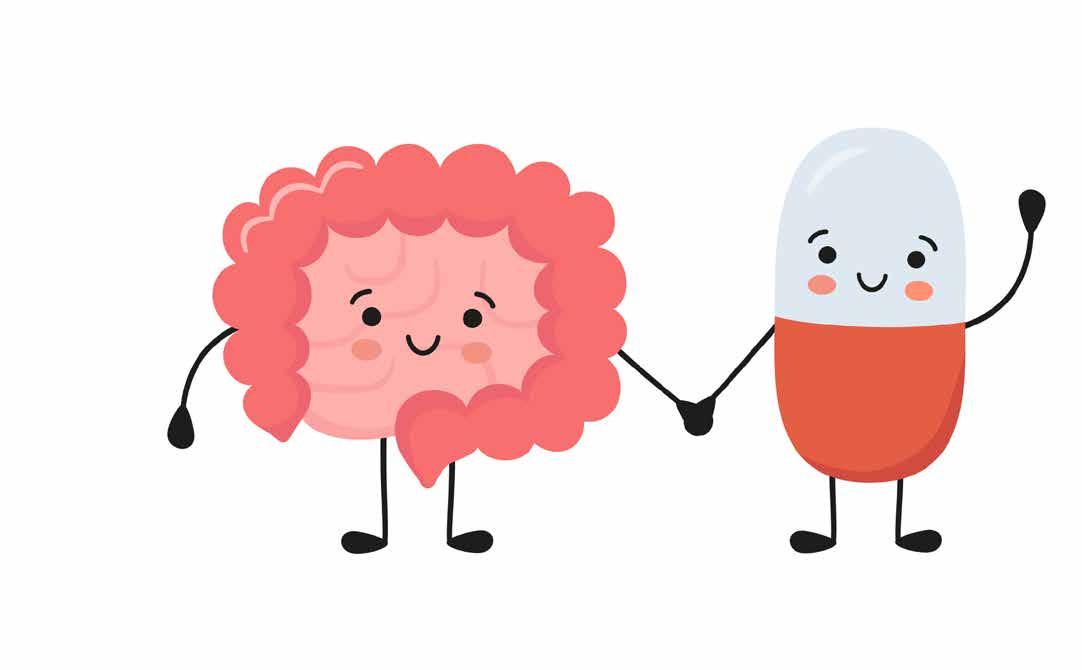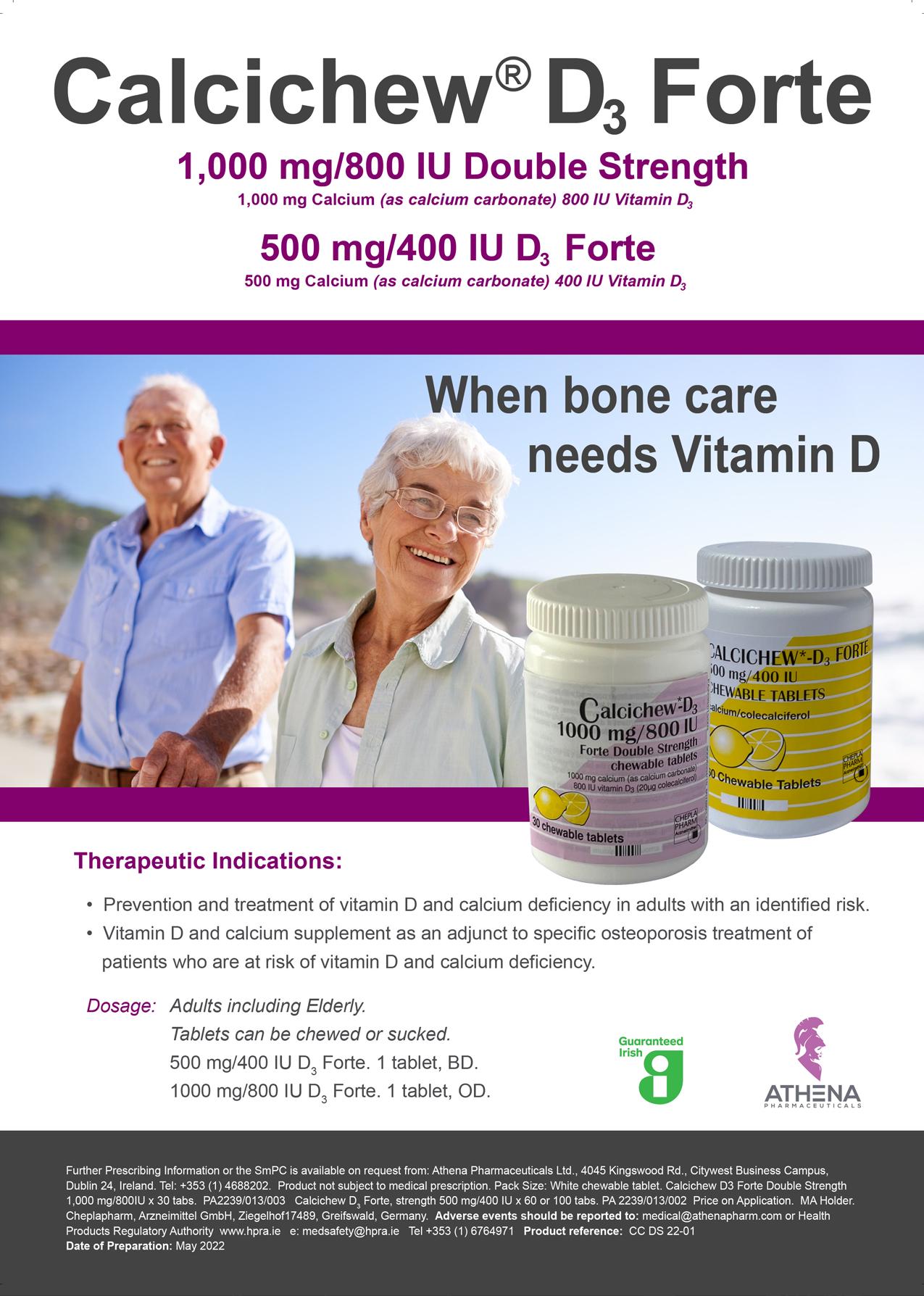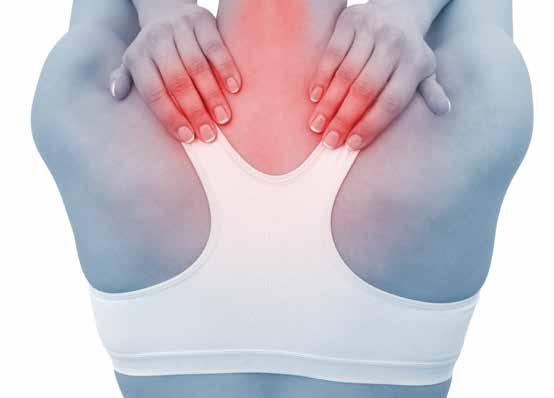
26 minute read
FEATURE: PULMONARY HYPERTENSION IN COPD
Pulmonary Hypertension in COPD
Written by Dr Rosie Kelly, respiratory registrar and Professor Eddie Moloney, respiratory consultant Tallaght University Hospital
Chronic obstructive pulmonary disease (COPD) is a common, preventable, treatable disease that is characterised by persistent respiratory symptoms and airflow obstruction, usually caused by smoking. Approximately 10 percent of individuals aged 40 years or over have COPD, with estimates of over 500,000 people in Ireland having COPD, most undiagnosed and half of whom have moderate to severe disease, and prevalence increases with age.
Dr Rosie Kelly Professor Eddie Moloney

Disease course can vary from exertional breathlessness to progressive severe exacerbations requiring hospitalisation. COPD is diagnosed using spirometry with a measurement of forced expired air in one second (FEV1) over forced vital capacity (FVC), the total volume of air expelled in a forced effort. A persistent obstruction in airflow will result in FEV1/FVC ratio of < 70 percent with. FEV1 also used to measure the severity of disease. Pulmonary function testing in a pulmonary laboratory allows for measurement of lung volumes (air trapping and hyperinflation pattern usually seen in COPD) and diffusion capacity for carbon monoxide (DLco) between lung alveoli and pulmonary capillaries. DLco is usually reduced in COPD as a complication of alveolar destruction due to emphysema and maladaptive pulmonary vascular changes which result in pulmonary hypertension. Pulmonary hypertension (PH) is a significant complication of COPD, seen commonly in moderate (FEV1 < 80 percent) to severe (FEV1 < 50 percent) disease, and the presence of PH has a significant impact on survival outcomes in COPD. Patients with PH are classified into 5 groups based on aetiology and classification, with group 3 pulmonary hypertension due to chronic lung disease and hypoxaemia, including COPD. Hypoxaemia from COPD results in pulmonary vascular endothelial cell injury promoting pulmonary vasoconstriction to try and maintain ventilation and perfusion balance, cellular proliferation and thrombosis. Given that the majority of COPD patients at risk of PH (moderatesevere disease) will experience breathlessness, a principal symptom of both COPD and PH, it is important to be vigilant in clinical examination of COPD patients for signs attributable to PH. Such findings include a loud second heart sound (P2), signs of right ventricular failure including a raised jugular venous pressure (JVP), an auscultatory third or fourth heart sound, a systolic murmur of tricuspid regurgitation, hepatomegaly, and peripheral oedema. If there is clinical suspicion, a number of non-invasive methods may give further clues. A six minute walk test will often show a rapid decline in oxygen saturations. A CXR may show right ventricular enlargement. An ECG may show signs of right ventricular hypertrophy (right axis deviation, dominant R wave in V1, a peaked P wave in leads II/III/ AVF), or right ventricular strain (ST depression and - T wave inversion in leads V1-V3). Transthoracic echocardiography (TTE) remains the investigation of choice due to its wide availability. While there is an agreed upon consensus for the definition of PH on pulmonary artery catheterisation (mean pulmonary artery pressure > 20 mmHg), definitions for PH on TTE are less well defined. TTE evaluates the probability of PH using the tricuspid regurgitant jet velocity (TRV). TRV along with right atrial pressure (RAP) can be used to estimate the pulmonary artery systolic pressure (ePASP). PH is suggested echocardiographically when the ePASP exceeds 35 mmHg, and/or when the right ventricular size, wall thickness, and function are abnormal.
However, due to variability in RAP, ePASP may poorly correlate with values obtained by right heart catheterization (RHC).Thus, we support guidelines issued by the European Society of Cardiology (ESC) and the European Respiratory Society (ERS) that propose use of the peak TRV together with echocardiographic findings of PH rather than ePASP to report the echocardiographic probability of PH. Regardless of whether the TRV or ePASP is used, these values should always be interpreted together with clinical suspicion and signs of RV dysfunction. When pulmonary dysfunction is severe enough to explain the degree of PH on echocardiography (eg, severe pulmonary dysfunction and mild PH), RHC is not indicated. RHC is usually reserved for those in whom the severity of PH on echocardiography is not explained by the severity of their underlying CLD (eg, moderate to severe PH with mild lung disease) or for those in whom an alternate aetiology is suspected. If PH is present in the setting of a relatively normal or mildly impaired FEV1, but DLco disproportionately low, a CT Thorax should be considered to check for co-existing interstitial lung disease with COPD, or pulmonary embolic disease. Should a diagnosis of group 3 PH be established, it is essential that the underlying disease process is managed as well as possible to prevent further progression. This includes smoking cessation and pharmacological therapy to reduce symptoms and reduce frequency and severity of exacerbations. This will aim to optimise lung function and limit hypoxaemia. For specific therapies targeting PH, a recent systematic review showed minimal benefit in pharmacological therapies for COPD-PH. Vasodilator treatment resulted in reduction of measured PAH however this failed to translate into symptomatic improvement or survival benefit for patients with COPD. The only treatment option that showed both haemodynamic and clinical benefits was long term oxygen therapy (LTOT). Guidelines for commencing LTOT in patients with COPD recommend its use in those who show evidence of moderate hypoxaemia (Pa02 <8 mmHg) with pulmonary hypertension and/or polycythaemia (haematocrit >55 percent) or severe hypoxaemia (Pa02 <7.3mmHg). LTOT, when used correctly at a minimum of 15 hours per day, could slow progression of PH and reduce mortality. Unfortunately, correction of hypoxaemia at this point is unlikely to reverse vascular remodelling. COPD-PH is a significant complication with direct impact on outcomes in a disease that already has significant morbidity and mortality. Recognition of this complication requires vigilance in clinical examination and an awareness of clues on readily available investigations such as six minute walk test, ECG, CXR and pulmonary function testing. Echocardiography can be used to diagnose PH but results should be interpreted in combination with the clinical picture, should results be incongruous referral for expert opinion for consideration of RHC should be sought. Management of COPD-PH remains focused on correction of hypoxaemia with targeted treatments to lower PAH showing minimal clinical benefits at this stage.
References available on request
Taxation of Pension Benefits in Retirement – A Guide to the Advantages
Tax and pensions in one headline! If I still have your attention don’t worry as this is a good news article with valuable information that will benefit you in retirement and give you peace of mind now.

Written by Colm Moore, CERTIFIED FINANCIAL PLANNER™, Moore Wealth Management
As part of our advice process, we offer full cashflow modelling that runs your financial future out to end of life and this factors in the tax you pay on your income in retirement. So, the first thing to clear up is that you do pay tax on your retirement income including the state pension, but the good news is that there are very generous allowances from revenue and with the proper advice and planning you can have an income of ¤73,600 per annum at an effective income tax rate of 10.15%
State Pension -Your Entitlement
The State Pension (Contributory) entitlement of an individual is calculated on their PRSI record and is then assessed under two methods (Yearly Averaging & Total Contributions Approach) with the individual’s entitlement being based on whichever provides the best outcome. In both cases it is a requirement that the individual has paid at least 10 years’ worth of PRSI. If you are unaware of your PRSI record, you can request this from your own www.mywelfare.ie login and is something you need to know. For a married couple with a full entitlement, this amounts to ¤26,343 per annum. If you wanted to buy that income in the open market via an annuity it would cost in the region of ¤700,000 so you can see the value of this.
Lump Sums
The first major advantage of having a pension is the entitlement to a tax-free lump on retirement up to revenue allowed limits. Currently you can take up to ¤200,000 completely tax-free and depending on your fund size and needs you can take the next ¤300,000 at a tax rate of 20%. If you combine both you can extract ¤500,000 which was an initially tax-relieved contribution from your business into your hands at an effective rate of 12% which is less than the tax relief you obtained thus making it a near tax neutral transaction. While it is rare to see someone extract this much at retirement with the excellent post-retirement options available it is still a choice.
Where someone makes a lump sum contribution into their pension near to business exit/sale to extract cash (as no buyer is looking to purchase cash), the tax relief will have two treatments depending on several factors. Some will be offset in the year of the contribution thus reducing the corporation tax liability and what is less well-known is that some can be carried forward in the company as an asset which is factored into the sale of the business.
Post Retirement
The balance of funds after the tax-free cash option in many cases goes into an Approved Retirement Fund (ARF). This is an extension of your pension planning that allows your accumulated funds to continue to grow tax-free and is drawn down as your needs dictate. To make sure that the funds do not sit indefinitely in your ARF revenue tax these under a practice known as Imputed Distribution. This means that from your 60th birthday onward they tax you under the assumption you have taken 4% of the fund from your ARF so you should a make withdrawal of at least this amount. From age 70 onwards this increases to 5%.
Planning Opportunity
The fact you need to extract 4% from your fund can be used for those who retire early and will not have another source of income who wish to continue to accumulate PRSI credits for the state contributory pension and the valuable benefit outlined above. To ensure that a PRSI record accrues towards the State Pension (contributory) a withdrawal of at least ¤5,000 in the relevant year would be required. That ¤5,000 withdrawal can be taken monthly, quarterly, half-yearly or as a single payment. In all cases where the total withdrawal or withdrawals equal or exceed ¤5,000 then the individual will accrue 52 Class S PRSI contributions which are essentially a full year’s worth of PRSI contributions.
This is a different approach to that of a standard private sector employee who would pay Class A PRSI and would only receive one Class A contribution for each week of work. Therefore, one ARF withdrawal of ¤5,000 or more will accrue 52 weeks’ worth of a PRSI record which it would take a private sector worker a full year of working to match. Again, this is vital information in your retirement planning.
Taxing your Income
With an ARF the plan is that you draw income from this in retirement to fund your lifestyle. As you do this you are looking at two things; The level of withdrawals which you hope can be sustained from investment performance and the level of tax you pay when combined with any other income. You want to keep your taxation level as low as possible.
Allowances
Between the personal, employee and aged tax credits a married couple will have ¤5,345 credits on top of an exemption from income tax that goes up to ¤36,000 which can give you marginal relief up to ¤73,600. The best way to illustrate this is with an example where we will take a couple where one spouse is age 66 and there are two pension funds with values ¤1.08m and ¤480k
Income Tax Tax as Liability a % of Income*
Spouse 1 ¤45,800 ¤5,515 12.10%
Spouse 2 ¤27,800 ¤1,915 6.90%
Jointly ¤73,600 ¤7,430 10.15%
* Note income is still subject to USC which is outlined below

What you will see above is that a couple can earn up to ¤73,600 in retirement at an effective tax rate of 10.15% when you factor in all allowances and credits. While this is an illustration of ARF income this could also be a combination of state pension, rental income and ARF withdrawals. In my view, this is a very strong case for funding your pension for retirement living and dispels the notion we hear about the effects of tax in retirement. Bear in mind that the income you are drawing down has accumulated and grown in the most benign and favourable tax environment that exists for investors in Ireland.
If the above example consists only of income from your ARF you will also have benefitted from two sizeable tax-free lump sums from your pension of circa ¤380,000.
USC and PRSI
You must however add USC to the above tax computations but again this is a benign rate in the age ranges below
Age 66 to 70 Band Tax Rate Income of ¤60,000
Up to ¤12,012 0.50% ¤60.06 Next ¤9,263 2% ¤185.26 Next ¤38,749 4.50% ¤1,743.70
Effective Rate 3.32% ¤1,989.02 Age 70+ Band Tax Rate Income of ¤60,000
Up to ¤12,012 0.50% ¤60.06 Next ¤47,988 2.00% ¤959.76
Effective Rate 1.70% ¤1,019.82
An important point to note is that you cease PRSI contributions once you reach 66.
How do we work this into our advice
We can run this backwards to your current starting position and see what level of pension funding you need to make now at conservative growth assumptions to get to for example the scenario above. By combining this with cashflow modelling which gives you an accurate picture of your financial future you can then invest with the appropriate amount of risk to achieve your goals. Our process is bespoke and comprehensive.
Important Update on Company Paid Pensions Changes
In our last article we mentioned that there were significant changes to the typical pension a company director in Ireland operated. The Pensions Authority shut off new access to these schemes and as yet we do not have a viable alternative. This means anyone who currently has one of these schemes has in their retirement planning armoury a supremely
efficient vehicle for cash extraction and wealth accumulation that a growing number of people wish they had. If you have not maximised the opportunities this pension gives you it’s in your best interest to have a consultation with a suitably qualified person to explain this opportunity while the option still exists. *Please note that all the above is subject to current tax rates and Budget 2023 has made the scenarios outlined above more favourable with the widening of tax bands. This should not be taken as tax advice, and you should always engage the service of your accountant and/or tax advisor when making your tax return. Colm Moore is a CERTIFIED FINANCIAL PLANNER™ with Moore Wealth Management. They have been advising the Irish Pharmacy community for over 20 years. If you have any questions on the above or would like to talk with Colm on any aspect of Financial Planning, he can be contacted on 086-8603953 or colm@mwm.ie
Considerations in Irritable Bowel Syndrome
Pharmacy teams can play an essential role for patients with Irritable Bowel Syndrome (IBS) by helping them identify symptoms, discussing possible treatment options, and educating them about the disease.
Counter assistants and staff can help to recognize patients who likely have IBS and either attempt to self-medicate with various OTC products such as herbal supplements or have prescriptions for antidiarrheals or laxatives.
Proactive questioning of the patient will allow pharmacy staff to assess the appropriateness of the medications or identify a need for referral to other health care professionals for further evaluation. Finally, it is also important to reassure the patient that IBS remains a manageable illness for the most part. Irritable bowel syndrome (IBS) is quite common with as many as 1 in 5 people affected. It is twice as common in women as men and happens most often to people in their 20s and 30s.

IBS is a disorder of the gut whereby the function of the gut is disturbed. However there are no physical or structural abnormalities. It causes a variety of symptoms, which are discussed in further detail below. It usually first appears in teenagers and young adults. Symptoms of IBS include loose, frequent stools, constipation, bloating, and abdominal pain and cramps. Patients may notice symptoms following the intake of specific foods or that symptoms, such as stool consistency or pain location, change over time. Patients may also present with headache, lethargy, nausea, bladder symptoms or faecal incontinence. Pain and discomfort may occur in different parts of the abdomen. Pain usually comes and goes. The length, severity and timing of each bout of pain can also vary greatly. The pain often eases when passing stools (motions or faeces) or wind. Many people with IBS describe the pain as a spasm or colic. Bloating and swelling of the abdomen may develop from time to time. Sufferers may pass more wind than usual. Other symptoms can sometimes occur and include: nausea (feeling sick), headache, belching, poor appetite, tiredness, backache, muscle pains, feeling quickly full after eating, heartburn, and bladder symptoms (an associated irritable bladder). Some people have occasional mild symptoms. Others have unpleasant symptoms for long periods. Many people fall somewhere in between, with flare-ups of symptoms from time to time.
Diet
Most IBS sufferers believe that certain foods cause or exacerbate their symptoms and thus exclude these foods from their diet. Insufficient evidence exists, however, to support exclusion diets or food allergy testing once lactose intolerance and celiac sprue are excluded. Alternatively, some may find it helpful to keep a food diary to determine if gas-producing foods (eg, beans, cabbage, onions, broccoli), carbonated drinks, sorbital, lactose, or wheat aggravate their symptoms and then avoid or limit them to determine if symptoms improve. Many IBS patients who seek medical care suffer from anxiety or depression and benefit from psychological therapies, including cognitive-behavioural therapy, hypnotherapy, and dynamic psychotherapy. Pharmacologic treatment is aimed at relieving the predominant GI symptom, but the goal should be to improve the overall or global symptoms, including altered stool frequency and consistency, abdominal pain and discomfort, bloating, and quality of life. Antispasmodics may provide short-term relief of abdominal pain and discomfort in IBS, but support for long-term efficacy is not available. Antispasmodics are associated with adverse effects (eg, dry mouth, blurred vision, dizziness, urinary retention), which may limit their use and should be avoided in IBS-C or IBS-M, as they may worsen constipation.
IBS and Heartburn
As many as 2 out of 3 people with IBS also have symptoms of GERD. GERD and IBS both impact segments of the digestive tract, but the connection between the two is unclear. Theories explaining the overlap include: • Pain sensitivity: Both conditions arise when nerves in the gut become over-sensitive (visceral hypersensitivity). This causes changes in the muscle contractions of the intestines and esophagus. • Confusion over symptoms: IBS patients with GERD symptoms may actually have functional
dyspepsia (indigestion). This is a milder form of GERD. Tests such as ambulatory oesophageal pH monitoring can confirm a diagnosis of GERD. • The broad definition of GERD:
GERD symptoms vary in severity. IBS-like symptoms may be part of the same spectrum of GERD, leading to patients reporting symptoms of both conditions.
Pharmacy Considerations:
- Am I aware of guidance which states sufferers should try to eat at about the same time each day to help regulate bowel function? - Am I aware of food triggers for IBS?
- Am I aware of the associated conditions and appropriate OTC medications which may help? - Ensure there is a discreet area within the pharmacy for customers to discuss their condition in a confidential manner
- Diet and lifestyle changes can go a long way to minimise
IBS flare-ups, am I confident in advising these changes to customers?

The Burden of Chronic Health Conditions
Researchers at Trinity, along with colleagues in RCSI University of Medicine and Health Sciences and the Economic and Social Research Institute (ESRI) have found that patients with more than one chronic health condition are under a significantly higher financial burden with healthcare expenses than those without a chronic health condition. Their findings, published in the journal BMJ Open, are particularly pertinent in the current cost-of-living crisis.

Healthcare is a major source of expenditure for patients in Ireland. The majority of people (59%) in Ireland aged 50 years or over have more than one chronic health condition. Chronic health conditions are health issues that can last a long duration, generally progress slowly, and are not passed from person to person. Examples include diabetes, arthritis, or depression. Individuals with more than one health condition are likely to have higher healthcare needs and higher out of pocket payments for healthcare. These high costs can lead to people choosing not to buy their medicines or not attending their healthcare appointments. The question researchers sought to answer was: How much more do people with multiple health conditions spend on healthcare, compared to those with no conditions?
The research team used data from The Irish Longitudinal Study of Ageing (TILDA) from 2016 to investigate the healthcare expenditure of a nationally representative sample of 5,899 adults aged 50 years or over.
Key findings:
• People with two chronic conditions had an average annual expenditure of ¤806.80, and people with three or more
conditions spent an average of ¤885.80. This compared to ¤580.30 for people with no chronic conditions. Therefore, people with two chronic conditions on average spent 39% more on healthcare than people with no chronic conditions, and people with three or more conditions spent on average spent 53% more than people with no chronic conditions. These figures are likely an underestimate as household adaptations and travel costs to access healthcare were not included in the analysis. • The biggest contributor to increased expenditure was medicines, accounting for approximately half of expenditure for people with two or more conditions.
• People with more than one condition had lower incomes, which means that some people with multiple conditions are spending a very large proportion of their income on healthcare.
For example, we found that almost 1 in 10 people with three or more conditions spent more than 20% of their income on healthcare.
• Having a medical card reduced healthcare expenditure by approximately half. • Though data was collected in 2016, there have been few changes to the medical card entitlements system in Ireland since then.
James Larkin, PhD Scholar, Department of General Practice, RCSI, and lead author said, “What is particularly concerning is that people with more than one chronic condition, not only have to spend more on healthcare, they also have lower incomes on average, meaning they do not have the ability to pay for some healthcare costs. Increasing the income threshold for the medical card, would likely be beneficial to people with more chronic conditions, especially considering the threshold has changed very little in the last 8 years. Furthermore, we know from previous Irish research that 31% of those entitled to a medical card are not availing of it. So to reduce financial burden, barriers to medical card uptake should be addressed. These barriers include lack of awareness of entitlement, potential stigma, and large administrative burdens.” Susan Smith, Professor of General Practice, Department of Public Health and Primary Care, School of Medicine, Trinity College Dublin, and Senior Author, added, “These results are concerning, especially when we consider the current cost of living crisis. People with multiple health conditions have higher healthcare expenditure and lower incomes. Inflation is leading to higher energy bills and fuel costs, meaning that the capacity for people with multiple health conditions to pay for their healthcare is shrinking even further.”
Susan Smith, Professor of General Practice, Department of Public Health and Primary Care, School of Medicine, Trinity College Dublin, and Senior Author
Antimicrobial Resistance
Among those hospitalised during the pandemic, both COVID-19 patients and those tested for SARS-COV-2 but negative, had higher rates of antibiotic-resistant bacterial infections compared to patients hospitalised before the pandemic, according to a study evaluating the pandemic’s impact on antimicrobial resistance (AMR) in 271 hospitals across the USA, presented at this year’s European Congress of Clinical Microbiology & Infectious Diseases (ECCMID) in Lisbon, Portugal.
The study also found that drug resistant infections were significantly higher in hospitalonset cases during the pandemic.
The COVID-19 pandemic presents many challenges for appropriate antibiotic use and stewardship, and there have been studies reporting that the pandemic was associated with AMR secondary infections, possibly due to the increase in the use of antibiotics to treat COVID-19 patients and disruptions to infection prevention and control practices in overwhelmed health systems. While conclusive evidence is lacking, these signals underscore the importance of continued monitoring of the impact of COVID-19 on AMR rates.
To provide more evidence, researchers conducted a multicenter, retrospective cohort analysis of all adults (aged 18 years or older) admitted to 271 hospitals across the USA before and during the COVID-19 pandemic, who had spent at least one day in hospital and had a record of discharge or death.
All admissions with at least one AMR infection (defined as a first positive culture for select gram-negative or grampositive pathogens resistant to antibiotics) were recorded. The analyses found that the AMR rate was 3.54 per 100 admissions before the pandemic and 3.47 per 100 admissions during the pandemic. However, patients who tested positive or negative for COVID-19 had higher levels of AMR than patients before the pandemic—4.92 per 100 admissions and 4.11 per 100 admissions, respectively.
A community pharmacy environment that fosters teamwork ensures high levels of consumer satisfaction. This series of articles is designed for you to use as a guide to assist your team in focusing on meeting ongoing CPD targets and to identify any training needs in order to keep the knowledge and skills of you and your team up to date.

Following on from the October issue Continuing Professional Development on the Management and Treatment of Acute Pain, this Team Training Module is designed to enhance the community pharmacy team understanding and ask further questions as to how you can support and advise patients. Pain is a distressing sensation, as well as an emotional experience. The International Association for the Study of Pain (IASP) defines pain as an unpleasant sensory and emotional experience associated with, or resembling that associated with, actual or potential tissue damage. In pain perception, three main stages generally occur, firstly pain sensitivity, then pain transmission from the periphery to the DH, and finally, transmission of these signals to the higher brain, e.g cortex, through nerves in the central nervous system (CNS). Transduction occurs initially. The painful stimulus is converted to chemical tissue events, then
chemical tissue and synaptic cleft events are converted into electrical events in the neurons, and finally electrical events in neurons are transduced as chemical events in the synapses. Transmission then occurs, i.e. the propagation of electrical events along the neuronal pathways and across synapses. Modulation then takes place at all levels of nociceptive pathways through the primary afferent neuron, DH and higher brain centres, up or downregulating the sensation. Pain can be grouped into three different classifications: nociceptive, neuropathic, and inflammatory: Nociceptive: Aδ and C-fibres are mostly found in superficial organs, such as the skin, whereas deeper structures such as muscles and joints are mainly supplied with C-fibres. There is an additional nociceptor type called silent nociceptors. These are located in the viscera and are usually
Consider:
Is the pharmacy team fully trained on the indications and benefits of all products for the treatment of acute pain?
How are pain relief products (oral and topical) displayed in the pharmacy?
Do we make the most of the potential for linked sales (e.g. oral and topical analgesics, food supplements, complementary therapies, support bandages)
Am I up to date with the latest guidance?
Am I aware which preparations are recommended first-line? insensitive to mechanical stimuli, but can be sensitised by the chemical mediators produced during inflammatory reactions. Neuropathic: this type of pain generally serves no purpose. It is commonly described as nerve injury or impairment and is associated with allodynia (central pain sensitisation). Nerve neurochemistry can be damaged after compression, stretching, or hyperexcitability propagated from other peripheral nerves. Inflammatory: This is a normal biological response to harmful stimuli that is required to start tissue repair. Neutrophils are usually the first cells to gather at the site of injury. Redness and swelling at the site of injury is due to the increased blood flow and increased vascular permeability, which can also induce pain. Pain is strongly associated with self-care management and acute pain is responsible for consumption of large quantities of over the counter (OTC) non-steroidal antiinflammatory drugs (NSAIDS). The aims of pain management should be discussed with each individual, but may include some or all of the following: Reducing the intensity of pain Enhancing physical functioning Improving psychological functioning Promoting return to work or school and/or role within family and society Improving health-related quality of life
Key Points:
The causes of acute pain, including the various types of injury
What types of pain can be considered for management in the pharmacy
Which customers should be referred to the pharmacist
The importance of not taking certain oral analgesics for longer than three days without referral
Questions to ask the customer A Cochrane review investigating the effects of analgesics/analgesic combinations (given as single doses postoperatively) concluded that there is evidence supporting the efficacy of these OTC drugs that are available without prescription, with ADRs generally not different from placebo. Paracetamol is a great first line choice for mild to moderate pain. It has no known GI, renal or cardiac adverse effects at the usual OTC and prescribed doses; however, the patient should be reminded of the maximum daily dose over 24 hours to reduce the risk of accidentally exceeding this. Codeine and paracetamol combination products should only be offered for e.g. managing acute lower back pain if an NSAID is not suitable or has been ineffective.
Caffeine does not have any pain relieving effect itself, but rather is added as an adjuvant to ibuprofen, aspirin and/or paracetamol products to enhance their analgesic effects. The most effective OTC drugs used were ibuprofen/ paracetamol combinations in 400mg/1,000mg and 200mg/500mg doses; respectively, providing relief to 70% of people, and with a NNT of less than 2.
Actions:
Ensure support staff understand the following key points: The common types of acute pain The characteristics of a good analgesic for OTC use in the treatment of acute pain The benefits and limitations of OTC medicines
The importance of what outcome a patient presenting with pain wants Lifestyle issues that may impact on pain recovery, and tips on improving lifestyle What approaches are recommended by the World
Health Organisation (WHO) analgesic ladder When to refer customers to the pharmacist.










